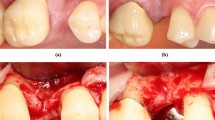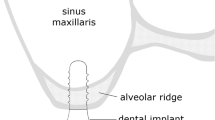Abstract
The biomechanics associated with buccal bone thickness (BBT) augmentation remains poorly understood, as there is no consistent agreement in the adequate BBT to avoid over-loading resorption or over-augmenting surgical difficulty. This study utilizes longitudinal clinical image data to establish a self-validating time-dependent finite element (FE)-based remodeling procedure to explore the effects of different buccal bone thicknesses on long-term bone remodeling outcomes in silico. Based upon the clinical computed tomography (CT) scans, a patient-specific heterogeneous FE model was constructed to enable virtual BBT augmentation at four different levels (0.5, 1.0, 1.5, and 2.0 mm), followed by investigation into the bone remodeling behavior of the different case scenarios. The findings indicated that although peri-implant bone resorption decreased with increasing initial BBT from 0.5 to 2 mm, different levels of the reduction in bone loss were associated with the amount of bone augmentation. In the case of 0.5 mm BBT, overloading resorption was triggered during the first 18 months, but such bone resorption was delayed when the BBT increased to 1.5 mm. It was found that when the BBT reached a threshold thickness of 1.5 mm, the bone volume can be better preserved. This finding agrees with the consensus in dental clinic, in which 1.5 mm BBT is considered clinically justifiable for surgical requirement of bone graft. In conclusion, this study introduced a self-validating bone remodeling algorithm in silico, and it divulged that the initial BBT affects the bone remodeling outcome significantly, and a sufficient initial BBT is considered essential to assure long-term stability and success of implant treatment.








Similar content being viewed by others
References
Ahmad R, Abu-Hassan MI, Li Q, Swain MV (2013) Three dimensional quantification of mandibular bone remodeling using standard tessellation language registration based superimposition. Clin Oral Implant Res 24(11):1273–1279
Ali B, Meddah HM, Merdji A (2013) Effects of overloading in mastication on the mechanical behaviour of dental implants. Mater Des 47:210–217
Al-Shabeeb MS, Al-Askar M, Al-Rasheed A, Babay N, Javed F, Wang H-L et al (2012) Alveolar bone remodeling around immediate implants placed in accordance with the extraction socket classification: a three-dimensional microcomputed tomography analysis. J Periodontol 83(8):981–987
Benic GI, Mokti M, Chen CJ, Weber HP, Hämmerle CH, Gallucci GO (2012) Dimensions of buccal bone and mucosa at immediately placed implants after 7 years: a clinical and cone beam computed tomography study. Clin Oral Implant Res 23(5):560–566
Chen J, Rungsiyakull C, Li W, Chen Y, Swain M, Li Q (2013) Multiscale design of surface morphological gradient for osseointegration. J Mech Behav Biomed Mater 20:387–397
Chen J, Ahmad R, Suenaga H, Li W, Swain M, Li Q (2015) A comparative study on complete and implant retained denture treatments–a biomechanics perspective. J Biomech 48(3):512–519
Crupi V, Guglielmino E, La Rosa G, Vander Sloten J, Van Oosterwyck H (2005) Numerical analysis of bone adaptation around an oral implant due to overload stress. Proc Inst Mech Eng Part H: J Eng Med 218(6):407–415
Degidi M, Nardi D, Daprile G, Piattelli A (2012) Buccal bone plate in the immediately placed and restored maxillary single implant: a 7-year retrospective study using computed tomography. Implant Dent 21(1):62–66
Field C, Li Q, Li W, Swain M (2008) Influence of tooth removal on mandibular bone response to mastication. Arch Oral Biol 53(12):1129–1137
Field C, Li Q, Li W, Thompson M, Swain M (2010) Prediction of mandibular bone remodelling induced by fixed partial dentures. J Biomech 43(9):1771–1779
Frost HM (2003) Bone’s mechanostat: a 2003 update. Anat Rec A Discov Mol Cell Evol Biol 275(2):1081–1101
Frost HM (2009) Wolff’s Law and bone’s structural adaptations to mechanical usage: an overview for clinicians. Angle Orthod 64(3):175–188
Grunder U, Gracis S, Capelli M (2005) Influence of the 3-D bone-to-implant relationship on esthetics. Int J Periodontics Restor Dent 25(2):113–119
Hsu M-L, Chen F-C, Kao H-C, Cheng C-K (2007) Influence of off-axis loading of an anterior maxillary implant: a 3-dimensional finite element analysis. Int J Oral Maxillofac Implants 22(2):301–309
Huiskes R, Weinans H, Grootenboer H, Dalstra M, Fudala B, Slooff T (1987) Adaptive bone-remodeling theory applied to prosthetic-design analysis. J Biomech 20(11):1135–1150
Kitamura E, Stegaroiu R, Nomura S, Miyakawa O (2004) Biomechanical aspects of marginal bone resorption around osseointegrated implants: considerations based on a three-dimensional finite element analysis. Clin Oral Implant Res 15(4):401–412
Kuchler U, von Arx T (2014) Horizontal ridge augmentation in conjunction with or prior to implant placement in the anterior maxilla: a systematic review. Int J Oral Maxillofac Implants 29:14
Lee T, Staines A, Taylor D (2002) Bone adaptation to load: microdamage as a stimulus for bone remodelling. J Anat 201(6):437–446
Li J, Li H, Shi L, Fok AS, Ucer C, Devlin H et al (2007) A mathematical model for simulating the bone remodeling process under mechanical stimulus. Dent Mater 23(9):1073–1078
Liao Z, Yoda N, Chen J, Zheng K, Sasaki K, Swain MV et al (2016) Simulation of multi-stage nonlinear bone remodeling induced by fixed partial dentures of different configurations: a comparative clinical and numerical study. Biomech Model Mechanobiol 16:411–423
Lin D, Li Q, Li W, Swain M (2009) Dental implant induced bone remodeling and associated algorithms. J Mech Behav Biomed Mater 2(5):410–432
Lin D, Li Q, Li W, Duckmanton N, Swain M (2010) Mandibular bone remodeling induced by dental implant. J Biomech 43(2):287–293
Merheb J, Quirynen M, Teughels W (2014) Critical buccal bone dimensions along implants. Periodontol 2000 66(1):97–105
Nisapakultorn K, Suphanantachat S, Silkosessak O, Rattanamongkolgul S (2010) Factors affecting soft tissue level around anterior maxillary single-tooth implants. Clin Oral Implant Res 21(6):662–670
Norman GR, Streiner DL (2008) Biostatistics: the bare essentials. BC Decker, Hamilton
Pieri F, Nicoli Aldini N, Marchetti C, Corinaldesi G (2013) Esthetic outcome and tissue stability of maxillary anterior single-tooth implants following reconstruction with mandibular block grafts: a 5-year prospective study. Int J Oral Maxillofac Implants 28(1):270–280
Rungsiyakull C, Rungsiyakull P, Li Q, Li W, Swain M (2011) Effects of occlusal inclination and loading on mandibular bone remodeling: a finite element study. Int J Oral Maxillofac Implants 26(3):527–537
Rungsiyakull C, Chen J, Rungsiyakull P, Li W, Swain M, Li Q (2015) Bone’s responses to different designs of implant-supported fixed partial dentures. Biomech Model Mechanobiol 14(2):403–411
Svensson KG, Trulsson M (2011) Impaired force control during food holding and biting in subjects with tooth-or implant-supported fixed prostheses. J Clin Periodontol 38(12):1137–1146
Tan Z, Kang J, Liu W, Wang H (2018) The effect of the heights and thicknesses of the remaining root segments on buccal bone resorption in the socket-shield technique: an experimental study in dogs. Clin Implant Dent Relat Res 20(3):352–359
Tanasić I, Tihaček-Šojić L, Mitrović N, Milić-Lemić A, Vukadinović M, Marković A et al (2015) An attempt to create a standardized (reference) model for experimental investigations on implant’s sample. Measurement 72:37–42
Tanasić I, Šarac D, Mitrović N, Tihaček-Šojić L, Mišković Ž, Milić-Lemić A et al (2016) Digital image correlation analysis of vertically loaded cylindrical Ti-implants with straight and angled abutments. Exp Tech 40(4):1227–1233
Teughels W, Merheb J, Quirynen M (2009) Critical horizontal dimensions of interproximal and buccal bone around implants for optimal aesthetic outcomes: a systematic review. Clin Oral Implant Res 20(s4):134–145
Veltri M, Ekestubbe A, Abrahamsson I, Wennström JL (2015) Three-dimensional buccal bone anatomy and aesthetic outcome of single dental implants replacing maxillary incisors. Clin Oral Implants Res 27:956–963
Wang C, Zhang W, Ajmera D, Zhang Y, Fan Y, Ji P (2015) Simulated bone remodeling around tilted dental implants in the anterior maxilla. Biomech Model Mechanobiol 15:701–712
Weinans H, Huiskes R, Grootenboer HJ (1992) The behavior of adaptive bone-remodeling simulation models. J Biomech 25(12):1425–1441
Yoda N, Zheng K, Chen J, Li W, Swain M, Sasaki K et al (2017) Bone morphological effects on post-implantation remodeling of maxillary anterior buccal bone: a clinical and biomechanical study. J Prosthodont Res 61(4):393–402
Acknowledgements
This study was supported by Australian Research Council (ARC) through Discovery scheme (DP160104602). We greatly appreciate Dr Michael Hogg for the invention of the open-source pyvCT package.
Author information
Authors and Affiliations
Corresponding author
Ethics declarations
Conflict of interest
Authors have no conflict of interest concerning the present manuscript.
Additional information
Publisher’s Note
Springer Nature remains neutral with regard to jurisdictional claims in published maps and institutional affiliations.
Rights and permissions
About this article
Cite this article
Zheng, K., Yoda, N., Chen, J. et al. Effects of buccal thickness augmentation on bone remodeling after maxillary anterior implantation. Biomech Model Mechanobiol 19, 133–145 (2020). https://doi.org/10.1007/s10237-019-01200-x
Received:
Accepted:
Published:
Issue Date:
DOI: https://doi.org/10.1007/s10237-019-01200-x




